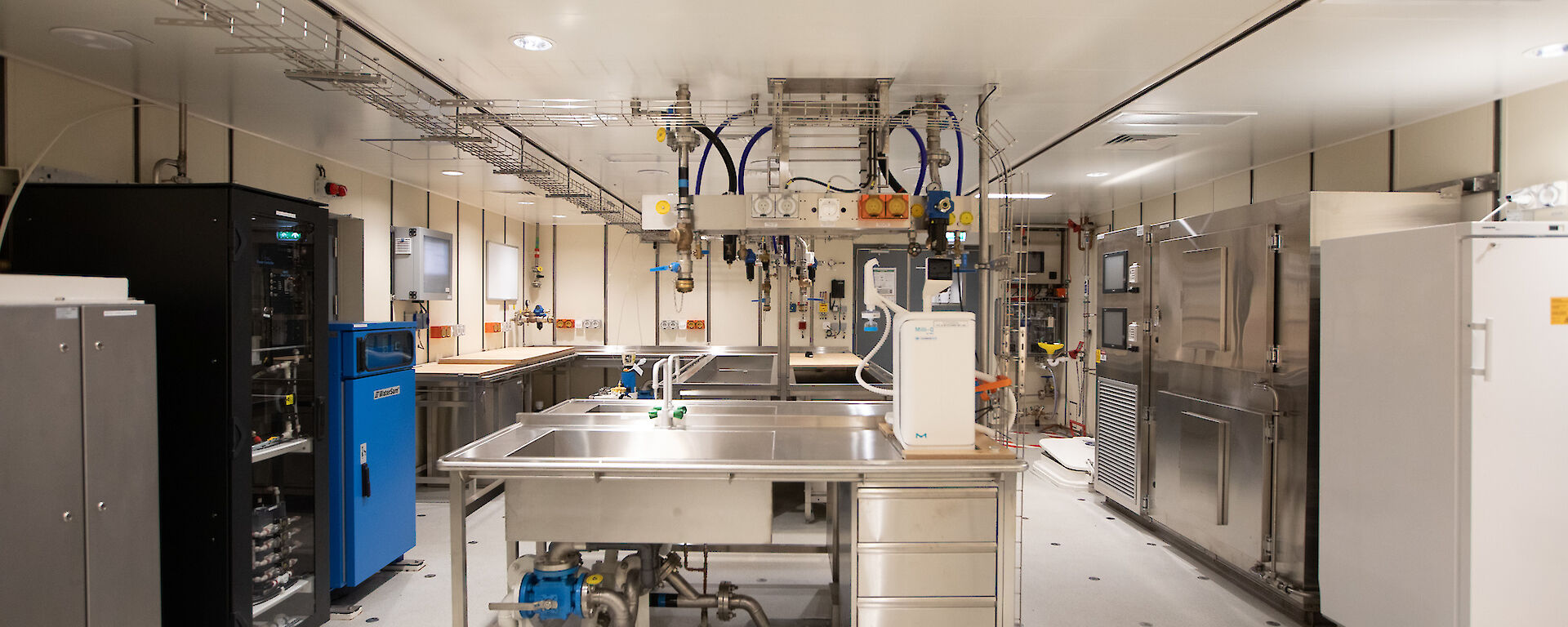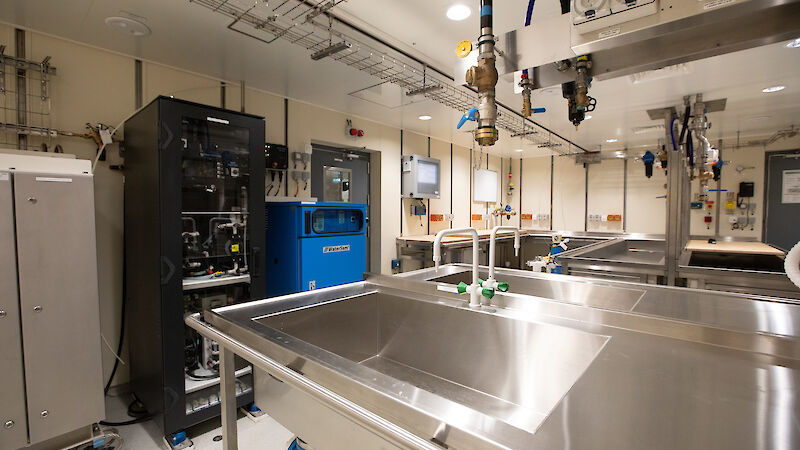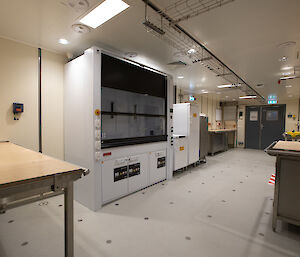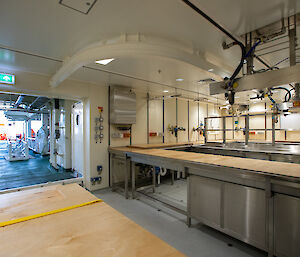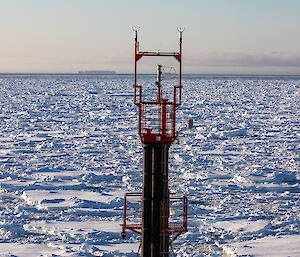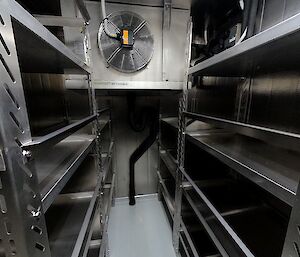Effectively a floating research station, RSV Nuyina has over 315 m2 deck space dedicated to fixed laboratories. This includes 2 dry labs, 2 wet labs, an air chemistry space, a meteorological lab, and the wet well area. Specialised systems can deliver uncontaminated seawater to fixed and containerised labs, and science and safety equipment is in place to support a variety of research projects.
Fixed Laboratories
- Air chemistry space: 1 x 26.3 m2; 2 x pipes in aerosol mast (one with a rotating sample head and manifold, the second for voyage specific sampling lines for instruments mounted on the mast or up the temporary service way). Pipe to run air to fixed labs or hatch lid container labs
- Dry laboratories: 1 x 49.3 m2; 1 x 44.8 m2
- Meteorological Lab: 1 x 35.1 m2
- Wet laboratories: 1 x 71.0 m2; 1 x 68.0 m2
- Wet Well: 1 x 21.0 m2
Uncontaminated seawater system (UCSW)
The availability of clean seawater is critical to keeping collected marine organisms alive and in pristine condition, or conducting marine-based experiments in the labs. RSV Nuyina has a specialised system to deliver uncontaminated seawater to various areas of the ship.
The UCSW system supplies a total of not less than 600 litres per minute of uncontaminated seawater at a pressure between 200 kPa and 500 kPa. It also ensures that the temperature change is not more than 0.5 degrees Celsius from the seawater intake to the various supply locations. The system will maintain water pressure and average water residence time not greater than 60 seconds.
Linked to the UCSW system is a seawater sensor suite which includes instrumentation to measure the following:
- Acidity (pH)
- Conductivity, temperature and salinity (thermosalinograph)
- CO2 concentrations in seawater
- Fluorometer with flow through chamber measuring fluorescence
- Fluorometer measuring turbidity and chlorophyll
- Laser optical particle counter
- Optical dissolved O2 sensor
- Seawater inlet temperature
- System pressure and flow rate
Science Equipment
Ultra-low freezers: 2 x -86 °C ultra-low freezers; 1 x -135 °C ultra-low freezer
C channel: All science spaces and aft deck
Chemical storage freezers: 2 x -18 °C x 100 L (1 in each wet lab); 2 x -18 °C x 70 L (1 in each dry lab)
Chemical storage fridges: x 4 (1 in each wet lab; 1 in each dry lab)
Compressed instrument air (pure): Outlets in all fixed labs
Electronics racks: dedicated racks in all labs
Flammable and corrosive chemical storage cabinets: vented (x 11)
Fume cupboards: x 5 with H&C potable water, UCSW, vacuum and compressed air outlets (1 in each lab and 1 in electronics room)
Ice machine: makes up to 20 kg of granular ice
Liquid nitrogen bulk storage and dispenser vessels: 2 x 200 L
Power outlets: 240 V 10 A including UPS availability
Reagent Grade Water outlets: to fixed labs and science container service interfaces
Temperature and light controlled growth cabinets: 1 in each wet lab
Trace metal free seawater: outlets in fixed wet lab and aft science Decks 4 & 5
Ultra pure (Milli Q) water
Vacuum waste system in labs
Walk-in cool & cold stores: science sample store rooms
Safety Features
Extensive manual handling equipment: forklifts, trolleys, elevators
Science Alarm Monitoring System: Integrated with ship's IPMS alarm & monitoring system
Safety showers and eye wash stations: 7 x stations in labs and other science areas
Science Gas: Science gas bottles are contained in six dedicated gas bottle stores. LPG, nitrogen, argon, helium, and carbon dioxide gases from these are piped via temporary cableways to the science laboratories and to the forward and aft science lab containers. These gases are also piped to the Wet Well and the Meteorological Laboratory. Low-pressure hydrogen generators can be used in the two dry labs and nine science container labs and oxygen can be supplied to six science laboratory containers. All bases served by science gas are protected by gas detectors and those that are served by the piped gas have a shutdown arrangement that activates a shutdown solenoid on the gas supply line(s). This shutdown solenoid is triggered in three ways: manually, by a low pressure signal indicating leakage and by the activation of a gas detector.

